Honglei Su
Perceptual Quality Assessment of Trisoup-Lifting Encoded 3D Point Clouds
Oct 09, 2024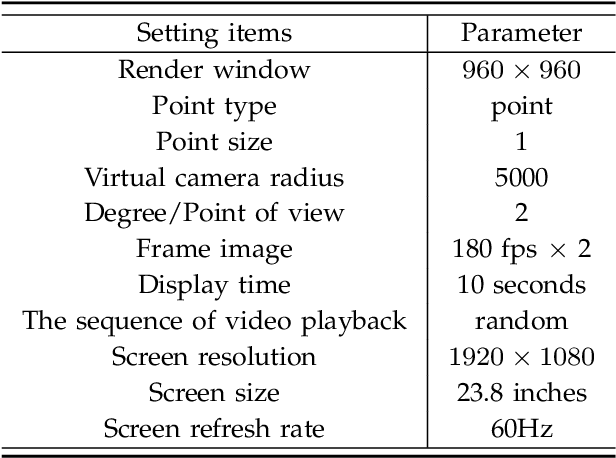
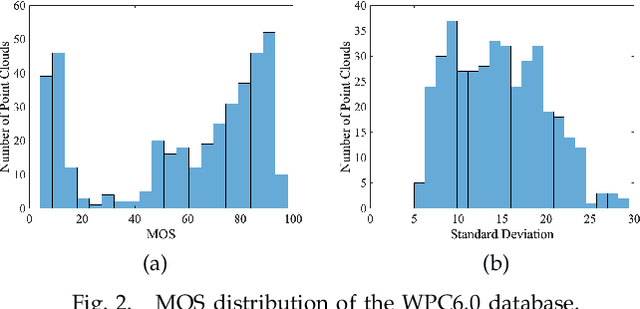
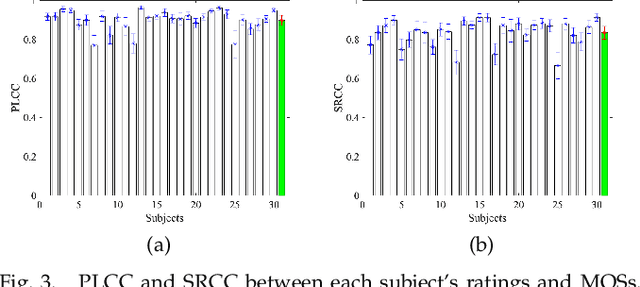
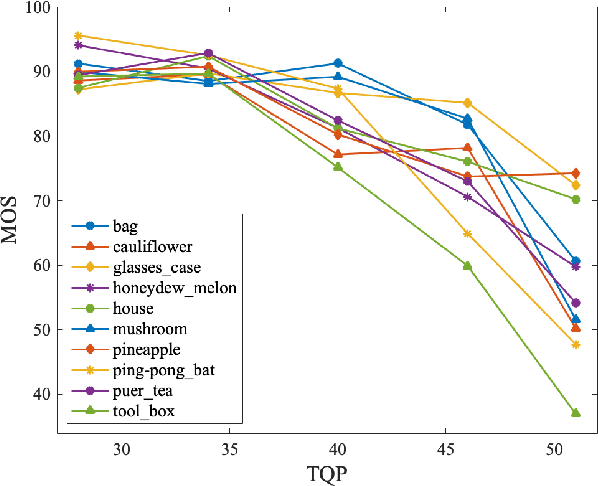
Abstract:No-reference bitstream-layer point cloud quality assessment (PCQA) can be deployed without full decoding at any network node to achieve real-time quality monitoring. In this work, we develop the first PCQA model dedicated to Trisoup-Lifting encoded 3D point clouds by analyzing bitstreams without full decoding. Specifically, we investigate the relationship among texture bitrate per point (TBPP), texture complexity (TC) and texture quantization parameter (TQP) while geometry encoding is lossless. Subsequently, we estimate TC by utilizing TQP and TBPP. Then, we establish a texture distortion evaluation model based on TC, TBPP and TQP. Ultimately, by integrating this texture distortion model with a geometry attenuation factor, a function of trisoupNodeSizeLog2 (tNSL), we acquire a comprehensive NR bitstream-layer PCQA model named streamPCQ-TL. In addition, this work establishes a database named WPC6.0, the first and largest PCQA database dedicated to Trisoup-Lifting encoding mode, encompassing 400 distorted point clouds with both 4 geometric multiplied by 5 texture distortion levels. Experiment results on M-PCCD, ICIP2020 and the proposed WPC6.0 database suggest that the proposed streamPCQ-TL model exhibits robust and notable performance in contrast to existing advanced PCQA metrics, particularly in terms of computational cost. The dataset and source code will be publicly released at \href{https://github.com/qdushl/Waterloo-Point-Cloud-Database-6.0}{\textit{https://github.com/qdushl/Waterloo-Point-Cloud-Database-6.0}}
No-Reference Point Cloud Quality Assessment via Weighted Patch Quality Prediction
May 13, 2023



Abstract:With the rapid development of 3D vision applications based on point clouds, point cloud quality assessment(PCQA) is becoming an important research topic. However, the prior PCQA methods ignore the effect of local quality variance across different areas of the point cloud. To take an advantage of the quality distribution imbalance, we propose a no-reference point cloud quality assessment (NR-PCQA) method with local area correlation analysis capability, denoted as COPP-Net. More specifically, we split a point cloud into patches, generate texture and structure features for each patch, and fuse them into patch features to predict patch quality. Then, we gather the features of all the patches of a point cloud for correlation analysis, to obtain the correlation weights. Finally, the predicted qualities and correlation weights for all the patches are used to derive the final quality score. Experimental results show that our method outperforms the state-of-the-art benchmark NR-PCQA methods. The source code for the proposed COPP-Net can be found at https://github.com/philox12358/COPP-Net.
Progressive Knowledge Transfer Based on Human Visual Perception Mechanism for Perceptual Quality Assessment of Point Clouds
Nov 30, 2022Abstract:With the wide applications of colored point cloud in many fields, point cloud perceptual quality assessment plays a vital role in the visual communication systems owing to the existence of quality degradations introduced in various stages. However, the existing point cloud quality assessments ignore the mechanism of human visual system (HVS) which has an important impact on the accuracy of the perceptual quality assessment. In this paper, a progressive knowledge transfer based on human visual perception mechanism for perceptual quality assessment of point clouds (PKT-PCQA) is proposed. The PKT-PCQA merges local features from neighboring regions and global features extracted from graph spectrum. Taking into account the HVS properties, the spatial and channel attention mechanism is also considered in PKT-PCQA. Besides, inspired by the hierarchical perception system of human brains, PKT-PCQA adopts a progressive knowledge transfer to convert the coarse-grained quality classification knowledge to the fine-grained quality prediction task. Experiments on three large and independent point cloud assessment datasets show that the proposed no reference PKT-PCQA network achieves better of equivalent performance comparing with the state-of-the-art full reference quality assessment methods, outperforming the existed no reference quality assessment network.
Perceptual Quality Assessment of Colored 3D Point Clouds
Nov 10, 2021

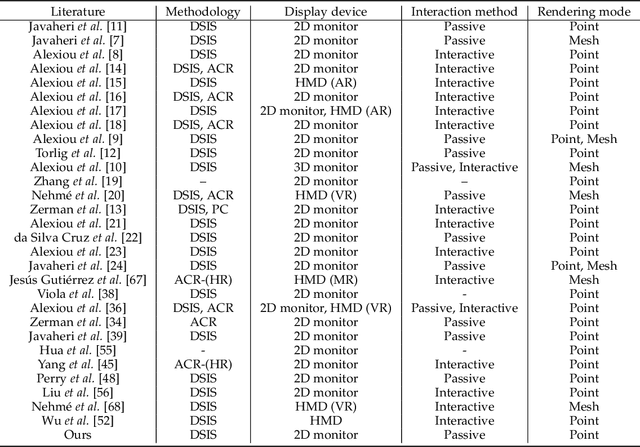

Abstract:The real-world applications of 3D point clouds have been growing rapidly in recent years, but not much effective work has been dedicated to perceptual quality assessment of colored 3D point clouds. In this work, we first build a large 3D point cloud database for subjective and objective quality assessment of point clouds. We construct 20 high quality, realistic, and omni-directional point clouds of diverse contents. We then apply downsampling, Gaussian noise, and three types of compression algorithms to create 740 distorted point clouds. We carry out a subjective experiment to evaluate the quality of distorted point clouds. Our statistical analysis finds that existing objective point cloud quality assessment (PCQA) models only achieve limited success in predicting subjective quality ratings. We propose a novel objective PCQA model based on the principle of information content weighted structural similarity. Our experimental results show that the proposed model well correlates with subjective opinions and significantly outperforms the existing PCQA models. The database has been made publicly available to facilitate reproducible research at https://github.com/qdushl/Waterloo-Point-Cloud-Database.
Reduced Reference Perceptual Quality Model and Application to Rate Control for 3D Point Cloud Compression
Nov 25, 2020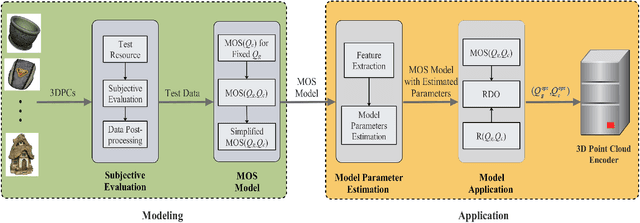
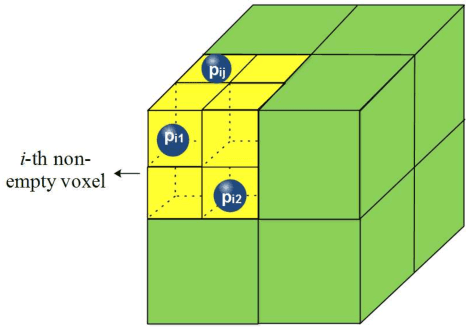
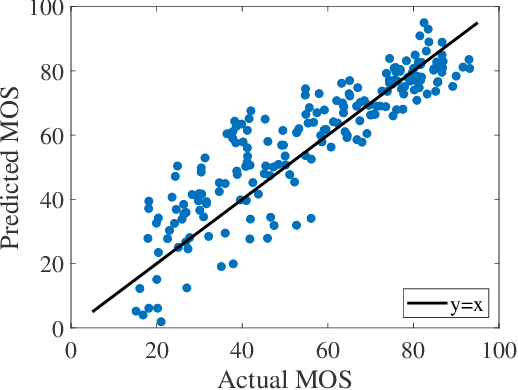
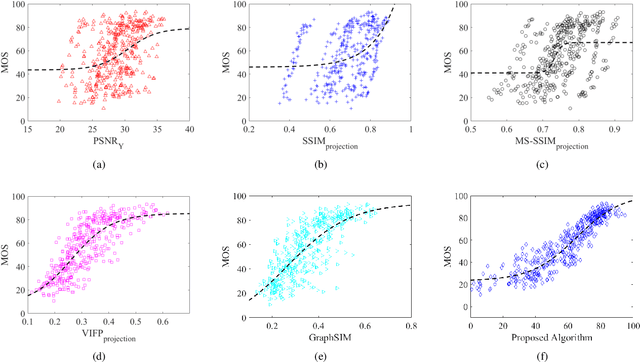
Abstract:In rate-distortion optimization, the encoder settings are determined by maximizing a reconstruction quality measure subject to a constraint on the bit rate. One of the main challenges of this approach is to define a quality measure that can be computed with low computational cost and which correlates well with perceptual quality. While several quality measures that fulfil these two criteria have been developed for images and video, no such one exists for 3D point clouds. We address this limitation for the video-based point cloud compression (V-PCC) standard by proposing a linear perceptual quality model whose variables are the V-PCC geometry and color quantization parameters and whose coefficients can easily be computed from two features extracted from the original 3D point cloud. Subjective quality tests with 400 compressed 3D point clouds show that the proposed model correlates well with the mean opinion score, outperforming state-of-the-art full reference objective measures in terms of Spearman rank-order and Pearsons linear correlation coefficient. Moreover, we show that for the same target bit rate, ratedistortion optimization based on the proposed model offers higher perceptual quality than rate-distortion optimization based on exhaustive search with a point-to-point objective quality metric.
 Add to Chrome
Add to Chrome Add to Firefox
Add to Firefox Add to Edge
Add to Edge